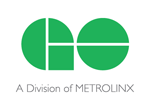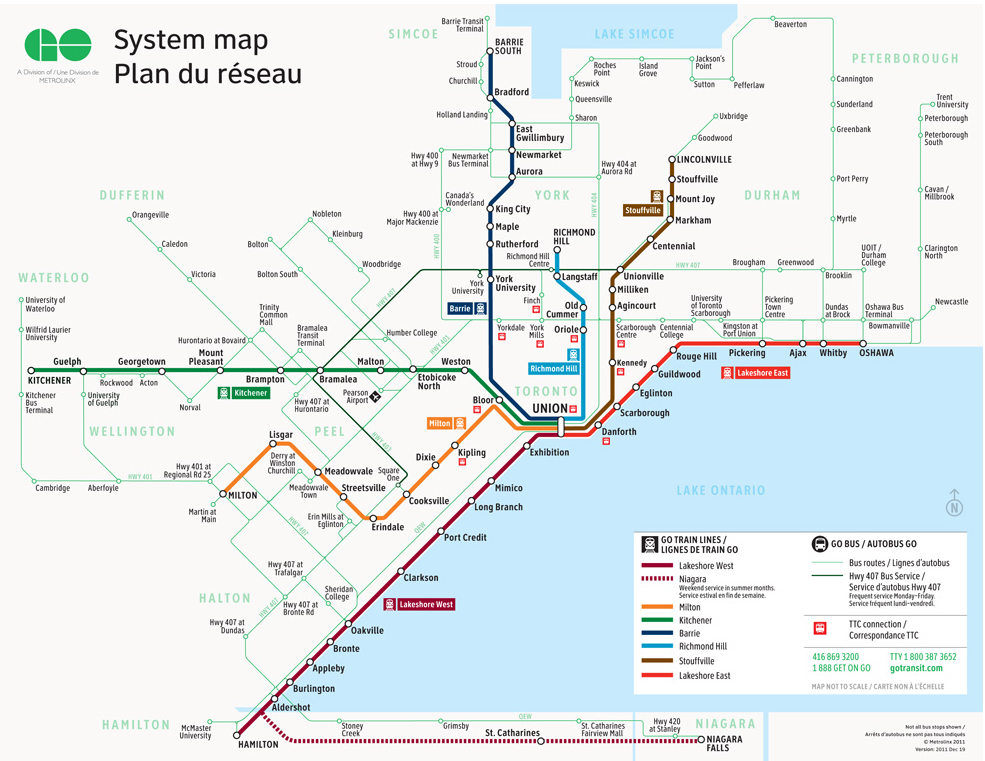Difference between revisions of "Metrolinx - GO Transit Maps and System Description"
From The RadioReference Wiki
m (updated categories) |
|||
| Line 21: | Line 21: | ||
*B '''Lakeshore East''' line (to Oshawa, with buses to Newcastle and Peterborough) | *B '''Lakeshore East''' line (to Oshawa, with buses to Newcastle and Peterborough) | ||
*C '''Milton''' line (to Milton, with buses to Waterloo) | *C '''Milton''' line (to Milton, with buses to Waterloo) | ||
| − | *D ''' | + | *D '''Kitchener''' line |
*E '''Barrie''' line | *E '''Barrie''' line | ||
*F '''Richmond Hill''' line | *F '''Richmond Hill''' line | ||
Latest revision as of 14:27, 4 August 2015
General Info
GO Transit is an interregional public transit system in Southern Ontario, Canada. It primarily serves the Greater Toronto and Hamilton Area, with operations extending to several communities beyond the GTHA proper in the Greater Golden Horseshoe. GO uses an extensive network of train and bus services; rail service is provided by diesel locomotives pulling trains of unpowered double-deck passenger cars, while most bus service is provided by inter-city coaches.
Canada's first such public system, GO Transit began regular passenger service on May 23, 1967 under the auspices of the Ontario Ministry of Transportation. Over time it has been constituted in a variety of public-sector configurations, today existing as a division of the provincial crown agency Metrolinx. Since 2009, GO Transit has operated under this organization.
Service area
The Greater Toronto and Hamilton Area (GTHA) consists of the City of Toronto, the City of Hamilton, and the surrounding Regions of Halton, Peel, York, and Durham. Each of these cities or regional municipalities has representation in GO's governance structures. GO Transit also reaches beyond the GTHA into Niagara and Waterloo Regions, and Peterborough, Simcoe, Dufferin, and Wellington Counties, although service to these non-GTHA jurisdictions is generally less extensive and, with some exceptions, bus-based only.
Present extrema are Hamilton and Waterloo to the west; Orangeville, Barrie, and Beaverton to the north; Peterborough and Newcastle to the east; and Niagara Falls to the south.
The GO system map shows seven train routes, all departing from Toronto's Union Station and mostly named respectively after the outer terminus of train service.
- A Lakeshore West line (to Hamilton, with buses and seasonal weekend trains to Niagara Falls)
- B Lakeshore East line (to Oshawa, with buses to Newcastle and Peterborough)
- C Milton line (to Milton, with buses to Waterloo)
- D Kitchener line
- E Barrie line
- F Richmond Hill line
- G Stouffville line (to Lincolnville, with buses to Uxbridge)
The Lakeshore East and West rail lines frequently operate on an interlined basis: most off-peak and some peak-period trains provide through service between stations east and west of Toronto. With this exception, however, direct movement between the various "legs" is quite limited. While several GO buses run on orbital routes that connect multiple legs, all rail-based interchange from one line to another (with the aforementioned exception of the Lakeshore lines) requires switching trains at Union Station. (Trains on multiple routes pass through or by each of the Bloor, Danforth and Scarborough railway stations, but each station is assigned to a single corridor and only accordingly-routed trains stop there.)
Buses Terminals
GO Bus service uses 15 bus terminals, with numerous intermediate stops and ticket agencies, in addition to providing off-peak and express services to GO Train stations.The terminals have a wide range of owner/operator/user relationships; GO owned facility with exclusive use or shared with local service; municipal transit operation shared by GO; intercity terminal shared with Greyhound, Coach Canada, etc. During the school year there are also thousands of rides a day to the York University Bus Loop, one of the biggest transit hubs in the GTA
- Ajax Bus Terminal
- Barrie Bus Terminal
- Bramalea City Centre Terminal
- Brampton Bus Terminal
- Finch Bus Terminal - former GO York Region Terminal
- Guelph Bus Terminal
- Hamilton GO Centre
- Kitchener Bus Terminal
- McMaster University Bus Terminal
- Newmarket Bus Terminal
- Oshawa Bus Terminal
- Richmond Hill Centre Terminal
- Scarborough Centre Bus Terminal
- Square One Bus Terminal
- Union Station Bus Terminal
- Yorkdale Bus Terminal
- York Mills Bus Terminal


